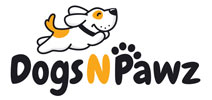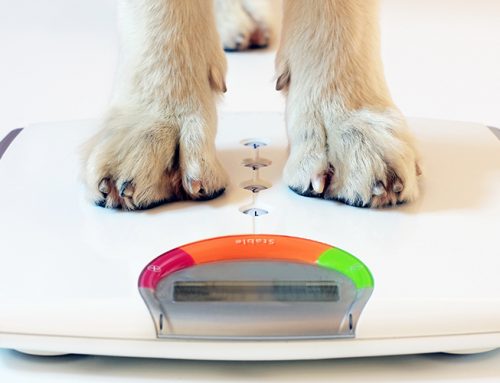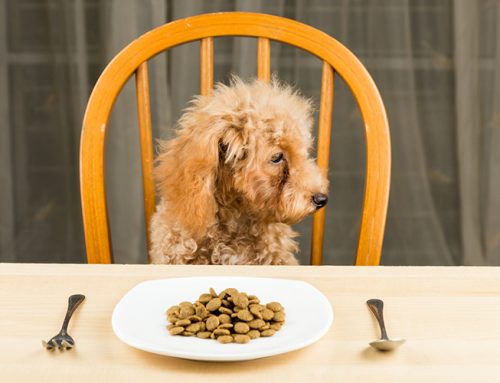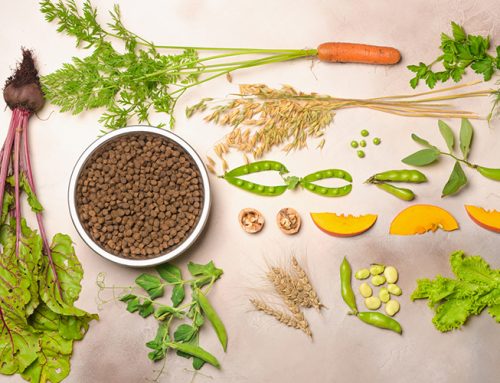Do I Need To Adjust My Dog’s Diet As It Ages?
Dogs have different nutritional needs at different ages. The most clear difference is in what adult dogs and puppies need to eat.
The Association of American Feed Control Officials, or the AAFCO, provides the guidelines for the ideal nutrients for adult dogs and puppies.
The major differences are in protein, fat and minerals minimum requirements:
Because these guidelines are different, most pet food brands offer puppy and adult dog specific formulations, although some dog foods are created for all “stages of growth” and labelled as such. It’s important to read the nutrition label to make sure all “stages of growth” food is providing the right amount of fat and protein for your dog, no matter its age.
There are no official guidelines for dogs at any other age, but your dog may require some special extras at various points in its life. If your dog develops a medical condition or allergies, its diet may need to be modified to meet its health needs.
How Should Puppies Eat?
“Puppies need to eat more in the way of protein (including higher concentrations of specific amino acids), fat, and certain minerals than do adult dogs,” according to PetMD. “Many manufacturers provide higher amounts of nutrients that are not regulated by AAFCO in their puppy foods. Good examples are the omega-3 fatty acids that have been shown to promote healthy brain and eye development in young animals.”
Plenty of brands offer puppy specific foods, and even offer puppy food directed at large breeds
Large breed puppies are at higher risk of certain orthopedic diseases and owners have to be careful their big pups don’t grow too quickly.
“Great Dane pups grow much faster than Chihuahuas, so they should eat different foods,” writes Lynn Buzhardt for VCA, a veterinary hospital brand available throughout Canada and the United States. “Large breed pups grow A LOT! But they should not grow up too fast.”
“In general, giant breed puppy foods should be lower in fat, have a good calcium content, an appropriate Ca:P ratio, and provide high quality protein,” the VCA article, Nutritional Requirements of Large and Giant Breed Puppies states. “The calcium content should be around 1.5%.”
Buzhardt recommends being careful about how much calcium puppies get and to make sure that treats are low in carbohydrates and don’t contain added calcium.
Small breed puppies also need a slightly modified diet.
“Small breed puppies, especially toy breeds, require careful feeding to prevent a condition called hypoglycemia,” the American Kennel Club (AKC) notes on its website. “This means they need to be fed a calorie-dense, small breed puppy food…”
Food labelled specifically for small breeds may provide smaller-sized kibbles, which are easier to eat without choking.
Puppies of any size need more calories than similarly sized adult dogs to support body growth and their oversized energy. Puppy food offers more calories per serving.
Dogs can switch to adult food when they are about 80 per cent of their full size — for large dogs, this can be anywhere from 12 to 18 months old. Some breeds don’t reach this metric until 24 months.
How Should Pregnant or Nursing Dogs Eat?
Solid, healthy nutrition is important for dogs being prepared for conception, when they are pregnant, and while they are nursing. Dogs are pregnant for about 62 days and it’s important they don’t lose weight during this time. A healthy dog should gain about 15 to 20 percent of her weight prior to giving birth.
Pregnant dogs in the first two trimesters need to eat the same as a young adult dog. In most cases, if they are eating a completed and balanced food, they will be getting enough nutrition during this period. Beware of overfeeding though — an overweight pregnant dog may experience troubles giving birth.
The last trimester puts the largest burden on a pregnant mom.
“The challenge during the third trimester … is the fact that the abdomen is filled with puppies, leaving little room for food in the gastrointestinal tract,” writes Krista Williams and Robin Downing, both doctors of veterinary medicine, for the VCA, in Feeding the Pregnant Dog. “A highly digestible, high quality puppy/growth/development formulation is generally recommended during the third trimester.”
In the third trimester, your dog may need 30 to 60 per cent more calories than it needs normally.
The authors also suggest offering the food in multiple small meals and advise against feeding large breed puppy food because it won’t have the right calcium phosphorus balance.
A lactating mom also needs plenty of food energy.
“Once the puppies are born, the mother can increase her food intake, but the energy density of the food must be high enough for she will not be physically able to consume enough to sustain milk production, weight, and body condition,” Williams and Downing write.
How Should Adult Dogs Eat?
Adult dogs without medical conditions are the most straightforward to feed. They can eat any food labelled “complete and balanced,” and expect to thrive.
Finding the right food in the right amounts for an adult dog may take some time — as a dog owner, you might have to try a few different brands or formulations before you find one your dog enjoys and that doesn’t cause allergies or extreme weight gain or loss. Finding the portion size may take some experimentation too. You can start with the recommended serving size for a specific product (based on the weight of your dog) and adjust from there. Active dogs need more caloric intake than low energy dogs.
As with puppies, there are dog foods for large and small breed adult dogs.
Many brands carry specific large breed food with unique formulations to address the nutritional needs of big dogs. Large breeds can be prone to osteoarthritis so a diet higher in fatty acids and glucosamine may be required. Your vet, breeder, or rescue facility will be able to provide specialized suggestions.
Small dogs and their tiny tummies also have unique needs.
“The differing metabolic rate of small versus large breed dogs continues into adulthood, which means that small dogs need to take in more calories per pound than large dogs. A little math reveals that the small dog requires 40 calories/pound, while his large breed friend needs only 22.5 calories/pound. Combine this with the fact that small dogs have tiny stomachs and you’ll see why most foods designed for small breeds are somewhat more calorie rich than large breed diets.”
Writes veterinarian Jennifer Coates, for PetMD
How Should Senior Dogs Eat?
Senior dogs are extra special to the people who love them. Our elderly fluffy friends tend to slow down and want to spend more time resting. Your lap might be more appealing than a walk in the park. Some breeds, like Labs, always seem hungry, and senior dogs can be prone to obesity because they are less active and still love to eat. Other dogs lose their appetites and get too skinny because they’re not eating enough to get a full complement of nutrients and calories.
What is a “senior” dog? Larger breeds, on average, don’t live as long as smaller dogs. A Chihuahua might be considered a senior dog at age nine, but a Great Dane might be considered senior at age five. Remember, just because a dog is a senior doesn’t mean it’s not in great health. Check with your vet if you think your dog is sliding into senior territory.
If a dog is showing signs of loss of vision, lumps under the skin, weight loss or gain, bad breath, excessive drooling or other dental issues, she or he might be feeling her years.
Other symptoms relating to aging are:
Memory loss
Confusion
Irritability
Personality changes
Loss of muscle mass
Increase in ‘accidents’ in the house
Osteoarthritis
There are no legal regulations setting nutritional requirements for pet food specifically marked for senior dogs. Pet owners need to read the ingredients and nutritional information to see if the food is actually formulated especially for seniors.
A healthy, active senior dog may not need any changes in its diet and can happily carry on munching its multi-stage or regular adult dog food.
Other senior dogs may benefit from some extras in its dinner bowl, including more fibre for digestion, softer textures (if your dog has experienced tooth loss or decay), joint supplements, and added Omega-3. There are strong proponents of a product called golden paste for senior dogs. Golden paste and its varieties usually contain high amounts of turmeric, which is a natural anti-inflammatory. This is a product dog owners can make or buy.
For overweight senior dogs: food with less fat and fewer calories is generally recommended. Treats can come in the form of a fresh piece of fruit or veggie (crunchy carrots for example).
For thin senior dogs: find a dog food that offers more calories per bite than a typical dog food. The calories should come from protein.
“Senior diets should have increased protein-to-calorie ratio, providing a minimum of 25 percent of calories from protein,” according to an article for the American Kennel Club.
Dogs with Medical Needs or Allergies
Dogs can develop medical conditions or allergies at any stage of their life, and their diets need to be adjusted. Depending on their condition, they may need a low calorie or high calorie diet, extra nutrients, higher protein, more fibre, softer foods, fewer ingredients — the variations are vast. Once you have a diagnosis, work with your vet to determine your dog’s new food requirements.
Dogs suffering from allergies may need to go through an elimination diet to determine what protein or grain is causing the excessive itching, upset stomach, constant chewing/licking, sneezing, watery eyes, yeasty smell etc. Vets can also provide guidance on determining your dog’s allergy and what food to try next.





